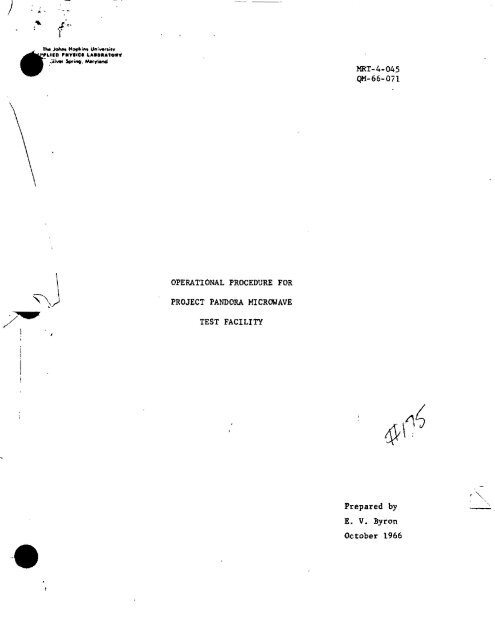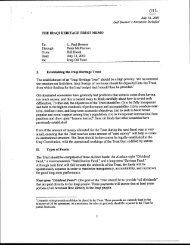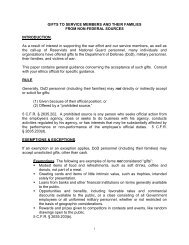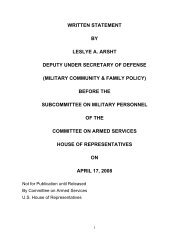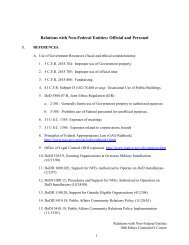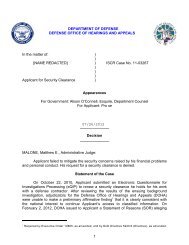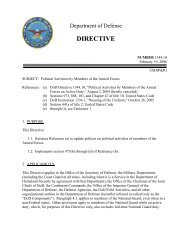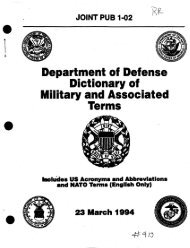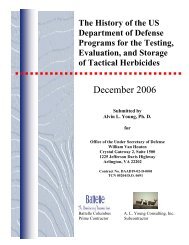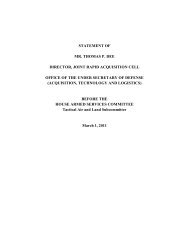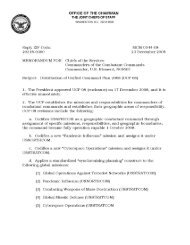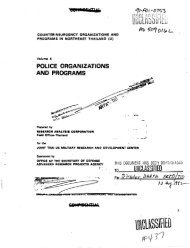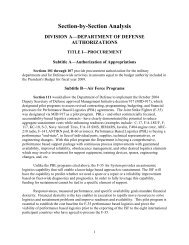OPERATIONAL PROCEDURE FOR PROJECT PANDORA ...
OPERATIONAL PROCEDURE FOR PROJECT PANDORA ...
OPERATIONAL PROCEDURE FOR PROJECT PANDORA ...
You also want an ePaper? Increase the reach of your titles
YUMPU automatically turns print PDFs into web optimized ePapers that Google loves.
"""'"" Uftn.r•h¥<br />
rM¥tJct: uaoaa To•Y<br />
s·w a.-mo. MMviMII<br />
I. INTRODUCTION<br />
MRT-4-045<br />
QM-66-071<br />
Page 1<br />
This report describes the operational procedure for the<br />
Project Pando.ra microwave test facility. It is intended pri<br />
marily for non-microwave oriented technical personnel, to<br />
enable them to operate the facility with a minimum of training.<br />
Section II of this report del!neates the basic turn-on, turn-off<br />
procedure for the equipment. Section III describes the procedure<br />
for determining which of the "add-on" sections of the expandable<br />
conical horn to use, and the power requirements for a desired<br />
power density. Section IV describes the power monitors in the<br />
microwave anechoic chamber,<br />
The microwave equipment for Project Pandora is assembled in<br />
the four equipment racks illustrated in figure 1. Rack No. 1<br />
contains the Spectrum Analyzer R.F. and Display sections, Rack<br />
No. 2 contains the auxiliary low-power microwave generation and<br />
modulation equipment. The equipment in this rack is not inter<br />
connected (nor is the spectrum analyzer}. Rack No. 3 contains<br />
the primary low power microwave generation and modulation equip<br />
ment, and the necessary monitoring and recording equipment. Rack<br />
No. 4 contains the high power microwave amplifier and power sup·<br />
plies. The interconnection of these two racks, with the "expandable<br />
horn" transmitting antenna in the anechoic chamber, is shown in<br />
figure 2 which is a functional block diagram of the microwave sys<br />
tem.<br />
II. EQUIPMENT OPERATION<br />
The following instructions pertain to the operation of the<br />
equipment assembled in equipment racks 3 and 4 with reference to<br />
figures l and 2.<br />
For operation of the various individual pieces of<br />
equipment, refer to the manufacturers' operation<br />
manuals which are available at the test facility.
·,<br />
The .tohM HoplliM Ufti-.lfy<br />
PM'fl* UM•ATOh<br />
Soli-- Scw .... IMtyklnd<br />
MRT-4-045<br />
QM-66-071<br />
Page 7<br />
formly a quiet zone large enough for a single test sample -<br />
1.5'W x l'H x l'D. At this frequency, n 10 gives the maximum<br />
power density obtainable for the system. As the frequency is<br />
decreased, horn section n 10 will uniformally illuminate a<br />
proportionately larger volume with reduced gain.<br />
1. The power required for a desired power density can be<br />
determined as in Al &bove.<br />
a. Example:<br />
IV. MICROWAVE POWER MONITORS<br />
2<br />
10 mw/cm power density is desired at<br />
3.95 GHz (Horn Section D 10 )<br />
Power<br />
Power Density<br />
Pd/W<br />
Pd/W<br />
-2<br />
= 3.83 x 10 from figure 3<br />
Power =<br />
10<br />
3.83 X 10 -3 ° m 260 watts<br />
In addition to the high power TWT monitor, there are 3 power<br />
monitors in the anechoic chamber. Two of these, Monitor #1, a<br />
standard gain horn, and Monitor #2, a sleeve dipole, are connected<br />
to the HP431C power meters in rack number 3. These two monitors<br />
may be switched to the Mosley 7100B strip-chart recorder (see figure 2).<br />
The third monitor, alternate monitor number 1, is a sleeve dipole and<br />
has an available output as shown in figure 2.<br />
A. Monitor Number 1<br />
Monitor number 1, the standard gain horn, is the primary<br />
"down stream" power density monitor. Power readings on the<br />
Channel No. 1 power meter can be converted to power density<br />
,!!! the point of measurement with reference to figure 5.<br />
Note: It must. be reemphasized that this monitor, in conjunction<br />
with. figure 5, measures the power density!! the point<br />
where the monitor£! placed £u the chamber, and not the<br />
power density at the center of the quiet zone as determined<br />
in Section III.
The JohN Hopllns Uftl..,•itw<br />
PMY81CI LAeo•atO•Y<br />
$ihlet SprinQ, Mlrylllnd<br />
External Distribution:<br />
P. Tamarkin<br />
R. s. Cesaro/5<br />
H. M. Grove<br />
R. w. Beard<br />
F. Koether<br />
J. Sharp<br />
MRT-4-045<br />
QM-66-071<br />
Page 15
Fig. 1 MICROWAVE ANECHOIC CHAMBER<br />
Q!i-66-072<br />
Page 17
. '<br />
TABLE I - continued<br />
16 Uov X Yes Stoppage same as during radiation,<br />
Stoppage of monkey work.<br />
17 Nov X Yes II<br />
18 Nov X Returns to normal<br />
19 Nov X<br />
20 Eov X<br />
21 Nov X<br />
22 l!ov X<br />
2) Nov X<br />
0<br />
24 liov X<br />
25 l!ov X<br />
26 Nov X<br />
27 Hov X<br />
28 Nov X<br />
29i;ov X<br />
30 llov X<br />
1 Dec X<br />
0<br />
2 Dec X<br />
3 Dec X<br />
4 Dec X<br />
5 Dec X<br />
6 Dec X
' '
FOIA CASE NO. 89-FOI-2208<br />
ATTACH A:<br />
1) MEMO FROM B. W. AUGENSTEIN TO DR. BROWN & DR. FUBINI, 13 MAY 65<br />
2) MEMO FROM R. S. CESARO, AIDIR., ADV SENSORS TO DIR., ARPA, 15 OCT 65<br />
3) MEMO FROM R. S CESARO, TO DIR., ARPA, 15 DEC 66<br />
4) MEMO FROM R. S. CESARO <strong>FOR</strong> RECORD, 20 DEC 66<br />
5) REPORT BY E. V. BYRON, JOHNS HOPKINS UNIV, <strong>OPERATIONAL</strong> <strong>PROCEDURE</strong> <strong>FOR</strong><br />
<strong>PROJECT</strong> <strong>PANDORA</strong> MICROWAVE, OCT 66<br />
6) REPORT BY E. V. BYRON, JOHNS HOPKINS UNIV., <strong>PROJECT</strong> <strong>PANDORA</strong>, NOV 66<br />
7) MEMO FROM R. S. CESARO, TO DIR .. DEF R&D, 27 SEP 67<br />
8) MEMO FROM HERBERT POLLACK TOR. S. CESARO, 2 JAN 69<br />
9) REPORT BY J. F. KUBIS, THESARATOGASTUDY, 8MAY69<br />
1 0) MINUTES OF <strong>PANDORA</strong> MEETING OF 17 JAN 69<br />
11) MINUTES OF <strong>PANDORA</strong> MEETING OF 21 APR 69<br />
1 2 ) MINUTES OF <strong>PANDORA</strong> MEETING OF 12 MAY 69<br />
13) MINUTES OF <strong>PANDORA</strong> MEETING OF 18 JUN 69<br />
1 4 ) MINUTES OF <strong>PANDORA</strong> MEETING OF 16 JUL 69<br />
1 5) MINUTES OF <strong>PANDORA</strong> MEETING OF 12& 13AUG69<br />
1 6) LTR FROM RAND, REVIEW OF <strong>PANDORA</strong> EXPERIMENTS, 4 NOV 69<br />
1 7 ) PRELIMINARY REPORT ON THE EVAWATION OF DATA ASSOCIATED WITH <strong>PANDORA</strong> BY J.<br />
F. KUBIS, 4 DEC 69<br />
1 8) MEMO FROM IDA REVIEW PANEL TOR. S. CESARO, 14 JAN 69
' ..<br />
.<br />
. .<br />
1 9 ) LETTER REPORT ON AO 791, 15 FEB 69<br />
2 0 ) PROGRESS REPORT BY B. H. COHEN, JOHNS HOPKINS UNIV., 28 FEB 70<br />
2 1 ) FINAL REPORT BY K. R BRIZZEE, TULANE UNIV., 16 SEP 70<br />
2 2) REPORT BY R. J. GAVALAS, UNIV OF CALIF AND D. 0. WALTER, ET AL, EFFECT OF LOW<br />
LEVEL. LOW-FREQUENCY ELECTRIC FIELDS ON EEG AND BEHAVIOR IN MACACA NEMESTRINA<br />
2 3) MINUTES OF <strong>PANDORA</strong> MEETING, 12 JAN 70<br />
2 4) FINAL REPORT BY ZARET FOUNDATION, INC.<br />
ATIACHB:<br />
AGREEMENT TRANSFER OF <strong>PROJECT</strong> <strong>PANDORA</strong><br />
ATIACHC:<br />
LETIER FROM DR. HEILMEIER TO WARREN G. MAGNUSON, 15 SEP 77
Mr. Michael Drosnin<br />
458 West Broadway, 5th Floor<br />
New York, NY 10012<br />
Dear Mr. Drosnin:<br />
Ref: 89-FOI-2208/L<br />
This responds to your December 5, 1989, Freedom of Information<br />
Act (FOIA) request to the Office of the Secretary of Defense<br />
which was received in this Directorate on December 12, 1989. Our<br />
interim response of December 21, 1989, refers.<br />
The Defense Advanced Research Projects Agency (DARPA) has<br />
determined that the documents at enclosure 1 are responsive to<br />
your request pertaining to Project Pandora and have been granted<br />
in full. Project Bizarre was not a separate project, rather, it<br />
was a code name for a special category within the Pandora<br />
Project. All other documentation relating to Project Pandora was<br />
transferred to the Walter Reed Army Institute of Research (WRAIR)<br />
per enclosure 2. The letter to Senator Magnuson at enclosure 3<br />
may serve to answer any further questions you may have.<br />
This office referred your request to the Services as previously<br />
indicated in our interim response. The Department of the<br />
Navy response of January 10, 1990, and the Department of the Air<br />
Force response of January 4, 1990, both correctly inform you that<br />
they are unable to assist you in your search for documents.<br />
WRAIR, under the Department of the Army, now has cognizance of<br />
this information as indicated in the previous paragraph and<br />
should be able to provide you a more substantive response.<br />
After deleting 100 pages as an "other" requester, the chargeable<br />
costs of processing your FOIA request consisted of 365 pages<br />
of office machine reproduction (with the documents provided in<br />
our interim response and this final response) at $0.15 per page.<br />
Please indicate the FOIA reference number above on a check or<br />
money order made payable to the U.S. Treasurer in the amount of<br />
$54.75. Send the payment within 30 days to this office at the<br />
following address:
Enclosures:<br />
As stated<br />
Office of the Assistant Secretary of Defense<br />
(Public Affairs)<br />
Directorate for Freedom of Information<br />
and Security Review<br />
Pentagon, Room 2C757<br />
Washington, DC 20301-1400<br />
Sincerely,<br />
w. M. McDonald<br />
Director<br />
Freedom of Information<br />
and Security Review<br />
CYT:LANGERMAN:mml:89-2208 1tr:900117: gr___pk ___ ye ___ wh<br />
2<br />
'
t __ ... '<br />
Uni..,.raity<br />
LAaORATORY<br />
<strong>OPERATIONAL</strong> <strong>PROCEDURE</strong> <strong>FOR</strong><br />
<strong>PROJECT</strong> <strong>PANDORA</strong> MICROWAVE<br />
TEST FACILITY<br />
MRT-4-045<br />
QM-66-071<br />
Prepared by<br />
E. V. Byron<br />
October 1966
')<br />
Section<br />
I.<br />
II.<br />
Ill.<br />
IV.<br />
Introduction<br />
TABLE OF CONTENTS<br />
Title<br />
Equipment Operadon<br />
A. .Preliminary·Turn-On Procedure<br />
B. Operational Turn-On Procedure<br />
c. Turn-Off Procedure<br />
MRT-4-045<br />
QM-66-071<br />
Procedure for Selecting Horn Sections, and Power 5<br />
for Desired Power Density<br />
A. Design Frequency Range for. 5<br />
"Expandable•• Conical Horn<br />
B. Horn Section for a Reduced Quiet.Zone 6<br />
Microwave Power Monitor 7<br />
A. Monitor No. 1 7<br />
B. Monitor No. 2 and Alternate Monitor No. 1 8<br />
- ii-<br />
1<br />
1<br />
2<br />
3<br />
4
.• 4 ,iL '<br />
c. Adjust Sweep Oscillator Output Attenuator for<br />
MRT-4-045<br />
QM-66-071<br />
Page 4<br />
maximum power output as observed on TWT Monitor<br />
Power Meter. Lock in position.<br />
d. Adjust TWT Output Attenuator for the required<br />
transmitted power as observed on the TWT Monitor<br />
Power Meter. Lt•ck in position.<br />
Note: The transmitted power required for a desired<br />
power density can be determined from figure 3<br />
and Section III of this procedure.<br />
The transmitted power can be determined from<br />
the meter reading and figure 4; (High Power<br />
Monitor, - Meter Reading vs. Output Power).<br />
DO NOT EXCEED 250 WATTS TRANSMITTED POWER <strong>FOR</strong><br />
EXTENDED PERIODS OF TIME WITH THE INITIAL TUBE<br />
SUPPLIED.<br />
e. Set the monitor switches on the monitor switct panel<br />
to connect the desired function to be monitored to<br />
the strip chart recorder. The normal setting of these<br />
switches is TWT Monitor to the recorder channel No. 2,<br />
and Monitor Channel No. 1 to recorder channel No. 1.<br />
f. Connect "Available Inputs" to the scope or the HP415<br />
as required.<br />
C. Turn Off Procedure<br />
l. Eguipment Rack Number 3<br />
a. Turn 10 W TWT Output Attenuator max. CW (max.<br />
attenuation).<br />
b. Turn Sweep Oscillator Output Attenuator max. CW.<br />
c. Turn Grid Control on Alfred 5-6868 10 Watt TWT to<br />
-250 volts. Turn Helix Control completely CCW.
d.<br />
MRT-4-045<br />
QM-66-071<br />
Page 5<br />
) '<br />
f (<br />
Turn HP692C Sweep Oscillator to Standby position.<br />
. e. Rack power may now be turned off . ' '<br />
2. Equipment Rack Number 4<br />
a. Set the Cathode Voltage switch on high voltage<br />
power supply to Burn-in position.<br />
b. Turn off high voltage/·<br />
'<br />
c. Turn off low voltage A.C. power supply.<br />
d. Turn off D.C.· power supply.<br />
e. Turn off water supply.<br />
III. <strong>PROCEDURE</strong> <strong>FOR</strong> SELECTING HORN SECTION AND OUTPUT POWER <strong>FOR</strong> DESIRED<br />
POWER DENSITY<br />
A. Design Frequency Range for "Expandable" Conical Horn<br />
The microwave facility was designed such that a suitable<br />
quiet zone- minimum dimension, 3' wide by 2' high by 1' deep<br />
for two "test samples" side by side - would be illuminated<br />
uniformly a + l.Odb power variation in the quiet zone was<br />
the design goal. The quiet zone, as discussed in this report,<br />
starts at a transmission length of 23.0 feet and is symmetric<br />
about the chambers horizontal and vertical axis. These quiet<br />
zone dimensions, therefore, set the beamwidth characteristics<br />
of the transmitting horn; and a conical transmitting horn with<br />
"add-on" section was designed to give maximum gain with the<br />
required beamwidth over the S-Band frequency range. Under<br />
these conditions, figure 3 shows the "design frequency range"<br />
for the appropriate sections (D 1 through D 6 ). This figure is<br />
a plot of power density (in rnw/cm 2 ) per watt transmitted - Pd/W -<br />
versus frequency, for each of the horn sections. It can be seen<br />
-2 2<br />
that, for the design frequency ranges, Pd/W is 1.6xl0 mw/cm + 10%.<br />
watt
FIGURE 6<br />
Horn Section Dimension<br />
Horn Section Diameter (inches)<br />
D1<br />
D2<br />
D3<br />
D4<br />
Ds<br />
D6<br />
D7<br />
D8<br />
D9<br />
DlO<br />
10.75<br />
11.75<br />
13.00<br />
14.00<br />
15.25<br />
16.75<br />
18.25<br />
20.00<br />
22.25<br />
24.5<br />
MRT-4-045<br />
QM-66-071<br />
Page 14
External Distribution:<br />
P. Tamarkin<br />
R. s. Cesaro/5<br />
H. M. Grove<br />
R. w. Beard<br />
F. Koether<br />
J. Sharp<br />
MRT-4-045<br />
QM-66-071<br />
Page 15
Internal Distribution:<br />
R. E. Gibson/2<br />
A. Kossiakoff<br />
A. M. Stone<br />
J. w. Follin/2<br />
J. L. Queen<br />
T. c. Cheston<br />
E. v. Byron<br />
Archives/2<br />
MRT-4 File<br />
MRT-4-045<br />
QM-66-071<br />
Page 16
Fig. 1 MICROWAVE ANECHOIC CHAMBER<br />
A."U\.J.- ..... -v..,.v<br />
QM-66-072<br />
Page t7
TOP OF"ECCOSORB'<br />
CV- CB18(F) WALKWAY<br />
SLEEVE<br />
DIPOLE<br />
MRT-4-046<br />
QM-66-072<br />
Page 29<br />
QUIET ZONE<br />
--- t -T<br />
________________ :(__<br />
5 SPLINE CABLE<br />
"TYPE N" TO<br />
5 SPLINE CABLE<br />
TRANSITION<br />
SUPPORT<br />
ROO<br />
SUPPORT BASE<br />
QUIET ZONE LOWER LIMIT<br />
NOT£:<br />
COMPLETE UNIT IS<br />
WRAPPED WITH<br />
"ECCOSORB" AN 75<br />
RG 9/U CABLE<br />
Fig. 13 FIX EO OIPOL E MONITOR , STRAIGHT DIPOLE
o.o 1·0
• ,<br />
.<br />
'<br />
APPENDIX A<br />
0 U!ICUSSIFIED 0
F. Tbe problem of variable power on the Saratoga in relation to<br />
the rotary pursuit and reaction time tests should be discussed<br />
with BioTechnology Inc.<br />
J,F,K.- (2-18-69)<br />
Walter Reed lbspital.
NINUTES OF PANOORA MEETING OF JUNE 18, 1969<br />
Meeting COnvened: 0930<br />
Meeting Adjourned: 1700<br />
IDA Rm. No.: lOKS<br />
Present:<br />
Science Advisory COmmittee<br />
Dr. Joseph E. Barmack<br />
*Dr. James N. Brown<br />
Dr. H. Allen Ecker<br />
Dr. Lysle H. Peterson, Chairman<br />
Dr. Herbert Pollack<br />
*Dr. Lawrence Sher<br />
*First Attendance<br />
Walter Reed Army Institute of Research<br />
Colonel Joseph V. ·Brady<br />
Dr. Thomas W. Frazier<br />
Mr. T. Daryl Hawkins<br />
Colonel Merrill C. Johnson<br />
Major James T. Mcilwain<br />
Mr. RichardS. Cesaro, ARPA<br />
Dr. John J. Collins, (CNO), USN<br />
Mr. H. Mark Grove, Wright-Patterson AFB<br />
Mr. Albert Rubenstein, ARPA<br />
Absent: Dr. Joseph Kubis, Science Advisory Committee<br />
Dr. Joseph C. Sharp, N. Y. State Dept. of Health<br />
Mr. Harris B. Stone, (CNO), USN<br />
(S) The minutes of the previous meeting (Hay 12, 1969)<br />
were discussed. Dr. Peterson explained that the questions<br />
regarding the WRAIR protocol were stated as thos·e which were<br />
raised for discussion at that meeting. The discussion associated<br />
with these questions resulted in a general agreement<br />
that the protocol in general provided an appropriate initial<br />
approach with human subjects. Furthermore, the nature of<br />
the problem together with constraints of available time,<br />
facilities, personnel and funds, and the scope of the approach<br />
result in statistical problems from the use of a small "n."<br />
A protocol using significantly more subjects would be more<br />
desirable but would delay the program considerably. It w·as<br />
agreed that for the first approach, the small "n" would be<br />
acceptable. The primary purpose of this meeting {June 16,<br />
1969) was to consider the apprOach in more detail and to<br />
hear reports from ARPA and WRAIR regarding broad approaches<br />
to the solution of the Pandora and related problems:
MINUTES OF <strong>PANDORA</strong> MEETING OF JULY 16, 1969<br />
Meeting Convened: 0930<br />
Heetinq Adjourned: 1700<br />
Neetinq Held: 0930 to 1330 at Building 503, Forrest Glen<br />
Annex of the Walter Reed Hospital<br />
Present:<br />
1400 ·to 1700 at IDA Rm. No. lOKS<br />
Science Advisory Committee Walter Reed Army Institute of Research<br />
Dr. Joseph E. Barmack<br />
Dr. James N. Brown<br />
Dr. H. Allen Ecker<br />
Dr. Joseph Kubis<br />
Dr. Lysle H. Peterson, Chairman<br />
Dr. Herbert Pollack<br />
Dr. Lawrence Sher<br />
·*First Attendance<br />
,,<br />
Colonel Joseph V. Brady<br />
Dr. Thomas W. Frazier<br />
Mr. T. Daryl Hawkins<br />
Colonel Merrill C. Johnson<br />
Major James T. Mcilwain<br />
Mr. RichardS. Cesaro, ARPA<br />
Dr. John J. Collins, (CNO), USN<br />
Mr. H. Mark Grove, Wright-Patterson AFB<br />
Mr. Albert Rubenstein, ARPA<br />
*Dr. Stanley Marder, IDA<br />
Dr. Joseph C. Sharp, N. Y. State Dept.<br />
•"· of Health. ? 4 F[::J
The experimental<br />
by Drs. Brady and Sharp with Dr. Sharp being assigned<br />
primary, direct responsibility for the operational conduct<br />
of the experimental program. The earliest studies were<br />
pilot studies. The same signal has been used throughout<br />
the study except for ,varied strength. This signal was<br />
selected from the "l1oscow signal" tapes by a group repre-<br />
.. senting various agencies. !1r. Mark Grove has had a ·major<br />
responsibility for providing the hardv1are to generate the<br />
selected "special" signal for 1'/RAIR. Primate behavior<br />
measures were chosen by WRAIR as the primary indicators.<br />
of an effect of the special signal. Studies comparing<br />
exposed ·and unexposed behavior were divided into three<br />
groups: 1. Reaction times, 2. Detection, and 3. Multiple<br />
schedule studies.<br />
1. Reaction Time: Tv1o types of experiments were performed<br />
. 2<br />
on· tlvO monkeys at 4.6 m1·1/cm ;<br />
(i) Shock avoidance (No. 682) 250 trials/day in midday<br />
. period and (Animal No. 683) · 500 trials/day; both<br />
a.m. and p.m. periods.<br />
Results;<br />
(a) No significant differences betv;een experimental<br />
(exposed) and nonexposed periods, and no ,signifi-<br />
'<br />
cant differences between a.m. and p.m. trials.<br />
>
Or'. Stephen Lukasik Page 3 4 November 1969<br />
WL-613<br />
For example, such a level might be in excess of 10 mw/cm 2 . The<br />
equipment used in a combined single-mode manner could certainly<br />
. produce approximately .this level of power.<br />
Another type of experiment that could be classified as behavioral<br />
was the reaction time studies. Four animals were used here, two with<br />
food reward and two using shock avoidance. The basic concept here is<br />
for the animal itself to adjust his reaction time to a comfortable value<br />
and to look at changes in this as a result of various stimuli or environmental<br />
conditions. Of the four tests run three showed no effect, one<br />
did show an effect but this effect could be either eliminated or emphasized<br />
by a change of the timing program. I believe, in general, these<br />
reaction time studies have been used in the behavioral field primarily<br />
for relatively short-term changes. Certainly there was some indication<br />
of statistically valid variations over a period of months but this could<br />
not be correlated to on/off times of the signal. It might be noted also<br />
that negative results were obtained for a tone substitution versus the<br />
microwaves for shock avoidance.<br />
In summary, you could say that there are some changes in the<br />
'distribution of the various parameters at various times but there were<br />
few or .none uniquely correlated with a special signal. There were certainly<br />
no trends observed, any statistically valid changes were single<br />
day, and there was certainly no evidence of anything that could be<br />
described as a catastrophic effect.<br />
The effect of low frequency modulation on the EEG has been<br />
reported a number of times by this project. Implanted electrodes are<br />
placed into various brain regions of the monkey and the resulting EEG<br />
tapes were analyzed off-line by Dr. Adey's laboratory in California.<br />
The time delays intrinsically involved in this process may be significant<br />
in explaining some of the experimental procedures followed or not followed.<br />
If the animals are irradiated by sine wave modulated at various low frequencies<br />
in the alpha region the autocorrelated power spectrum analysis<br />
shows reinforcement of the modulation frequency in various portions of<br />
the brain. At this date there is no convincing evidence that this effect<br />
is not an electrical artifact of the procedure. There are several variations<br />
of protocol which could determine this using an on-line system.<br />
I believe a fast-fourier transform analyser is on order for purposes of<br />
going on-line. Experiments were run with the animals' head shielded,<br />
under anesthesia, killed during the experiment, and even with a perfused<br />
brain. However, none of these were satisfactory for positive elimination
Director<br />
Advanced Research Projects Agency<br />
Washington, D. C. 20301<br />
Reference:<br />
ARPA Order Number:<br />
Program Code Nuti".ber:<br />
Name of Contractor:<br />
Date of Contrac:t:<br />
Amount of Contract:<br />
Contract Number:<br />
Principal Investigator:<br />
Contract Expiration Date:<br />
Short Title of Work:<br />
Gentlemen:<br />
15 February 1969<br />
Document No. 9G61-2<br />
791<br />
8Ml0<br />
Allied Research Associates. Inc., Concord. Mass.<br />
l August 1968<br />
$53,899.00<br />
DADA17- 69-C -9021<br />
J. Healer<br />
31 June 1969<br />
Review, Analysis, and Classification of Literature<br />
on the Biological Effects of Microwave<br />
Radiation<br />
This letter report is a resume of work performed during the second three<br />
months of the referenced contract.<br />
Information Base Source Material<br />
During this period a continuous search, acquisition and review of pertinent<br />
foreign and dorrtestic material on biological effects of radio-frequency radiation<br />
has been carried out. Approximately 700 relevant documents have been<br />
identified. Bibliographic cards have been prepared for most of these, and<br />
those items currently available in this country have been acquired. An<br />
unedited preliminary bibliogl'aphy covering new material added to the system<br />
is included as an Appendix to this report.<br />
Approximately 50 requests from Allied Research for information, abstracts<br />
and/or translations of foreign reports, and original language sources have<br />
been processed in this period by the Aerospace Technology Division of the<br />
Library of Congress.<br />
Preparation and Revision of Data Sheets<br />
New data sheets are being continuously prepared, with a total of about 135<br />
·completed to date. An additional bioscientist has been recently added to the<br />
project staff, in order to facilitate an accelerated rate of data sheet prepara-
";n
.,. ___ , ___ ,
4.. I .• Jlt<br />
4 copies<br />
20 copies<br />
3 copies<br />
1 copy<br />
DISTRIBUTION LIST<br />
Commanding Officer<br />
U S Army Hedical R & D Command<br />
Attention: HEDDH-SI<br />
Washington, D.C. 20314<br />
Defense Documentation Center<br />
Attention: DDCIR<br />
Cameron Station<br />
Alexaqdria, Virginia 22314<br />
Director<br />
Advanced Research Project Agency<br />
Washington, D.C. 20301<br />
Institute for Defense Analysis<br />
400 Army Navy Drive<br />
Arlington, Virginia ·22202
•<br />
TOP SECRE- 7 M AJ IC<br />
. £.Y •• ONLY<br />
'1'52-EXEMPT (E)<br />
Ol
EYES ON'LY<br />
TOP SECRF- I M AJ IC · 0<br />
EY- ONLY<br />
EYES ONLY TOP SECR!"; I MAJIC '1'52-Jo:XE:MFT (E)<br />
(') i\11 v<br />
•<br />
- - .
•••••••••••<br />
'l'OP SECRET •<br />
••••••••••••••<br />
-<br />
T52-EX:l>ll"l' (E)<br />
(II
. '· .,<br />
'- ,o 1o<br />
..... - '. .<br />
. .•. . :<br />
•• .. .<br />
EYES ONLY<br />
EYES ONLY<br />
TOP<br />
•ATTACHMENT<br />
TOP<br />
EYE<br />
I MAJIC ._<br />
Oi'iLY<br />
E'l} •<br />
• .,. -f\.1 A J I C<br />
TS2-EXD'I.PT (E)<br />
(I
....<br />
.. _ +7<br />
within the Pandora Scientific Advisory Board to review certain<br />
findings obtained to date inorder to reestablish valid, technical<br />
criteria lor conclusions that might be reached. The first ol these<br />
groups, to be beaded and chaired by Dr. Kubis, will be charged<br />
with determining whether or not the data can support that there<br />
have been microwave effects obtained so fa:r in the Pandora program.<br />
This step ie essential, ae you have already concluded, in revali·<br />
dating any conclusions that might be reached to date. Before this<br />
group can !unction, it will be necessary to have Dr. Kubis sit<br />
down with you and ex:plaln hie method of approach for the review<br />
of the data and obtain your auistance in its methods and in carrying<br />
it out. This same procedure will be followed with any other sub<br />
panel that the committee advises in any other area, i.e. the question<br />
of the signal. As we discussed, I concur in your establishing an<br />
internal WRAIR Sc:i.entl!lc Advisory Board to maintain a continuing<br />
technical review of the Pandora experiments already conducted as<br />
well as experiments to be conducted by WRAIR and all of its<br />
subcontractors.<br />
Any committee actlon requiring participation with WRAIR<br />
personnel and all relating data from e:!Cperiments in the Pandora<br />
program will be coordinated and arranged through your o!fice<br />
prior to any actions being undertaken.<br />
e. ARPA/AS WRAIR Relatione • 1 have round our written discuuions<br />
and program review to be exceedingly valuable to me in the future<br />
planning and conduct o£ the Pandora program. I would suggest that<br />
you and I arrange a monthly meeting to provide !'rogram review and<br />
take any actions that may be necessary. ·<br />
1 belill>ve the suggested management changes in the program fo't'<br />
the conduct of Pandora outlined within to be mutually beneficial and<br />
wlll result in providing a wide base from which to work in conducting<br />
these most dil!icult experiments.<br />
, .....<br />
Richard S. Cesaro<br />
Director<br />
Advanced Sensors
'I<br />
·'<br />
'<br />
,:<br />
1<br />
'<br />
\<br />
I<br />
\<br />
' \<br />
\<br />
"'<br />
eb :, •<br />
PAGE THREE<br />
•<br />
11. Is the On1ted States involved in developing any directed energy micro<br />
wave weapons?<br />
12. Is there any evidence that Eastern Block research on microwaves is<br />
being actively directed toward altering nervous system functions from a<br />
weapons point of view?<br />
-<br />
·.


